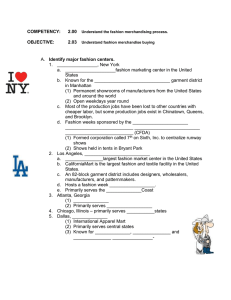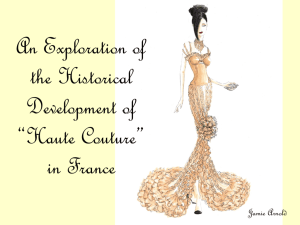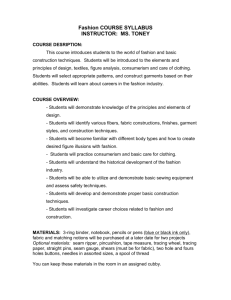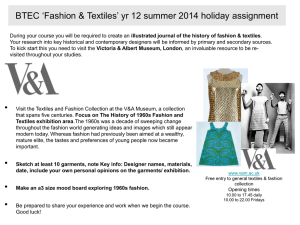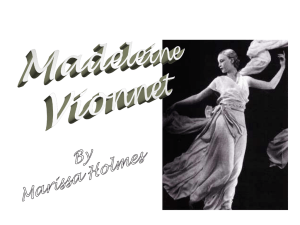Brochure - A Queer History of Fashion
advertisement
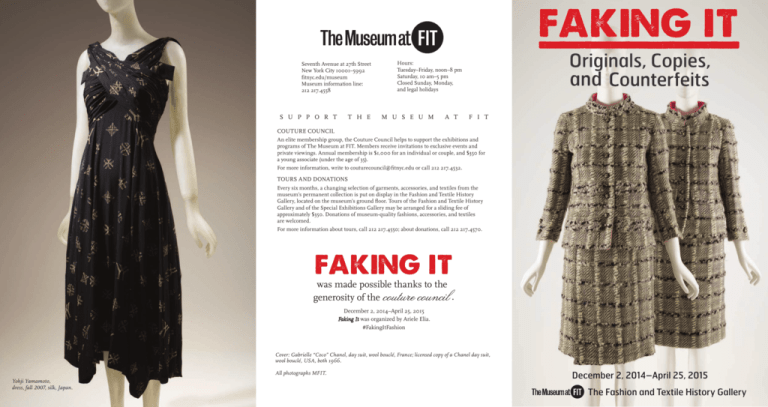
Seventh Avenue at 27th Street New York City 10001–5992 fitnyc.edu/museum Museum information line: 212 217.4558 S U P P O R T T H E Hours: Tuesday–Friday, noon–8 pm Saturday, 10 am–5 pm Closed Sunday, Monday, and legal holidays M U S E U M A T F I T COUTURE COUNCIL An elite membership group, the Couture Council helps to support the exhibitions and programs of The Museum at FIT. Members receive invitations to exclusive events and private viewings. Annual membership is $1,000 for an individual or couple, and $350 for a young associate (under the age of 35). For more information, write to couturecouncil@fitnyc.edu or call 212 217.4532. TOURS AND DONATIONS Every six months, a changing selection of garments, accessories, and textiles from the museum’s permanent collection is put on display in the Fashion and Textile History Gallery, located on the museum’s ground floor. Tours of the Fashion and Textile History Gallery and of the Special Exhibitions Gallery may be arranged for a sliding fee of approximately $350. Donations of museum-quality fashions, accessories, and textiles are welcomed. For more information about tours, call 212 217.4550; about donations, call 212 217.4570. was made possible thanks to the . generosity of the December 2, 2014–April 25, 2015 Faking It was organized by Ariele Elia. #FakingItFashion Cover: Gabrielle “Coco” Chanel, day suit, wool bouclé, France; licensed copy of a Chanel day suit, wool bouclé, USA, both 1966. All photographs MFIT. Yohji Yamamoto, dress, fall 2007, silk, Japan. December 2, 2014–April 25, 2015 The Fashion and Textile History Gallery F Couturière Madeleine Vionnet registered photos of her designs and, in 1923, began using her thumbprint to authenticate her label. She fought adamantly for the implementation of international copyright laws, but they were instituted only in France. Vionnet also worked with embroiderer Albert Lesage to develop a beading technique too complex to reproduce; however, an unauthorized version of her 1924 “Little Horses” dress shows that this strategy did not stop determined copyists. aking It: Originals, Copies, and Counterfeits investigates the history of authorized and unauthorized copying in fashion. The exhibition shows how licensing agreements and diffusion lines have blurred the definition of authenticity, and reveals strategies that designers have employed to combat knockoffs and counterfeits. Couturier Charles Frederick Worth began signing his name to his label during the early 1860s. Worth’s signed label further authenticated his exclusive designs—just as an artist’s signature does a painting. However, it also became an appealing target for forgers. “The problem of exclusivity,” says fashion historian Alexandra Palmer, “began as soon as specific names became associated with couture designs.” In 1913, couturier Paul Poiret discovered while visiting the United States that illegal copies of his designs—including his label—were selling for as little as $13. Because fashion designs were not protected by copyright in the U.S., Poiret fought back by trademarking his label. Unlicensed copy of Madeleine Vionnet’s “Little Horses” dress, rayon crepe, black and gold seed beads, circa 1925, USA. A promising solution to design piracy emerged in the United States during the 1930s. The Fashion Originators’ Guild of America allowed designers to register their work and manufacturers refused to do business with retailers who sold knockoffs of registered garments. But in 1941, the Federal Trade Commission cited the organization for “eliminating the right to free competition” and the guild disbanded. A fter World War II, Bergdorf Goodman began purchasing 80 to 100 couture samples each season in order to create licensed copies for its American clientele. Bergdorf’s employed highly skilled seamstresses to execute versions identical to the original couture garments. Similarly, Ohrbach’s department store imported couture samples of the latest Parisian styles on bond for six months. At its fashion shows, Orbach’s presented its copies alongside the couture samples in order to illustrate the faithfulness of their reproductions. While licensed copies made couture more widely available (and contributed to the postwar resurgence of the couture industry), variations in quality raised doubts about their authenticity. For example, a Chanel tweed suit from 1966 and its line-for-line copy appear to be identical, yet closer inspection reveals that the construction was modified to reproduce the suit at a lower cost. Licensed copying also resulted in further counterfeiting. Unscrupulous dealers would sell couture samples to New York manufacturers, who would produce unauthorized copies, which would also be copied, and so on, creating a spiral of declining quality. The House of Worth, afternoon dress, silk velvet, chenille, chiffon, 1903, France. Licensed copy of Pierre Balmain’s Angel evening dress, created by Orcilia in Santiago de Cuba, tulle, feathers, 1946-1947, Cuba. Some designers further expanded their markets during the late 1980s by creating less expensive diffusion lines, such as DKNY and Cheap and Chic by Moschino. Licensing deals such as Missoni for Target may also have blurred the definition of “authentic” designer items—although they have helped designers reclaim part of the market taken over by copyists. Still, the counterfeit market continues to flourish. Powered by the internet, it has become a multibillion-dollar industry. An internet shopper can purchase a fake Chanel 2.55 bag for only $38 and receive it from China within one week. Furthermore, the launch of Style.com in 2000, provided front-row access to fashion shows. Unlike copyists of the twentieth century, who relied on actual garments and sketches, manufacturers now have instant, digital access to the latest collections. Fast fashion companies can shamelessly knock off a look and have it in stores within two weeks, almost always beating Counterfeit Chanel 2.55 bag, plastic, metal, out the original designer. As Susan Scafidi, 2014, China. founder and academic director of the Fashion Law Institute, points out, these companies are willing to run the risk of being sued because “it’s probably cheaper to pay off a settlement than to actually buy a license.” E ven major designers sometimes reference each other in ways that provoke questions of trademark infringement. At his fall 2007 runway show, Yohji Yamamoto featured a number of garments and luggage with a new “YY” logo that was disarmingly similar to the Louis Vuitton logo. More recently, Los Angeles designer Brian Lichtenberg created a witty variation on the Hermès logo with his Homiés collection. Fashion lawyers are still debating whether Lichtenberg’s logo is a trademark violation or a parody—and, therefore, protected speech. France, Italy, and the United Kingdom now have strict laws against copying a unique fashion design, but there are still no such laws in the United States. The Innovative Design Protection Act of 2012 (IDPA) aims to protect designers’ intellectual property rights. This measure has been proposed in Congress, but has not passed. Meanwhile, debate still rages within the fashion industry over whether such an act would benefit creativity or stifle it. Whether or not fashion design will receive the same legal protections as music, art, publishing, and other creative fields remains to be seen. Ariele Elia, curator Brian Lichtenberg, Homiés ensemble, cotton, polyester, rubber, 2014, USA.



